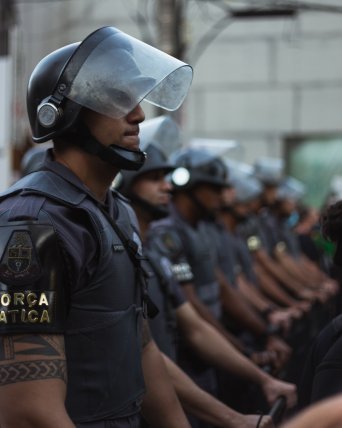- About
- Topics
- Picks
- Audio
- Story
- In-Depth
- Opinion
- News
- Donate
- Signup for our newsletterOur Editors' Best Picks.Send
Read, Debate: Engage.
| topic: | Political violence |
|---|---|
| located: | Brazil, Colombia |
| editor: | Ellen Nemitz |
While police violence is not a new problem, many countries still struggle to combat it. In Latin America, as well as in other parts of the globe, episodes of violence against individuals or groups continue to occur: in Colombia, for instance, Amnesty International documented some recent instances of violent repression against peaceful demonstrators. While the institution has issued a warning to the authorities since then, it has once again, in March 2023, released a set of 25 proposals for an "intersectional and human rights-based approach for comprehensive reform of the police."
The document, organised by a group of several Colombian human rights organisations, along with victims of excessive use of force, was sent to the president, Gustavo Petro. Among the main ideas to reform the Colombian police are demilitarisation, a redesign of its general structure and career paths to a new human-rights based model, limiting the use of force, establishing surveillance mechanisms and guaranteeing the rights of victims of police violence to truth, justice and reparations.
"We understand that many of the proposals presented here require deep policy and institutional changes," reads its introduction. "This document is, therefore, a call to the Colombian state to fully and truly assume the commitment to reform the National Police, including the National Government, the Congress of the Republic and the other actors involved."
When it comes to surveillance and accountability, technology is a useful ally. Last month, the mayor of Bogotá announced the distribution of video cameras to be worn by police officers. The initiative has so far proved itself effective in different places, including Brazil, where police interventions are often deadly. In 2019, the State of Santa Catarina was a national pioneer in installing body cameras on police suits in order to better control their actions and reduce unwanted violent events.
Since then, there has been a noticeable increase in the quality of police activity. A study carried out by researchers from international and Brazilian universities showed promising results: a 61 percent drop in the use of force by security agents, including the use of physical force, lethal and non-lethal weapons and handcuffs, for instance.
The project has spread to other parts of the country, with remarkable outcomes as well. In São Paulo, Brazil’s most populated state with over 46 million people, officers also started to use cameras attached to their suits. The number of deaths resulting from police interventions dropped by 57 percent as a result of the program, according to a report by the Getulio Vargas Foundation (FGV), compared to units in which the cameras were not being used. Within the offices that adopted the method, the decrease compared to the previous 12 months reaches 80 percent.
Among the reasons to which the researchers attribute the significant improvement in the quality of police interventions was a change in police officers' behaviour due to the existence of supervisory mechanisms, leading to a stronger adaptation of their actions to the protocols of the corporation.
Image by Rogério S.
